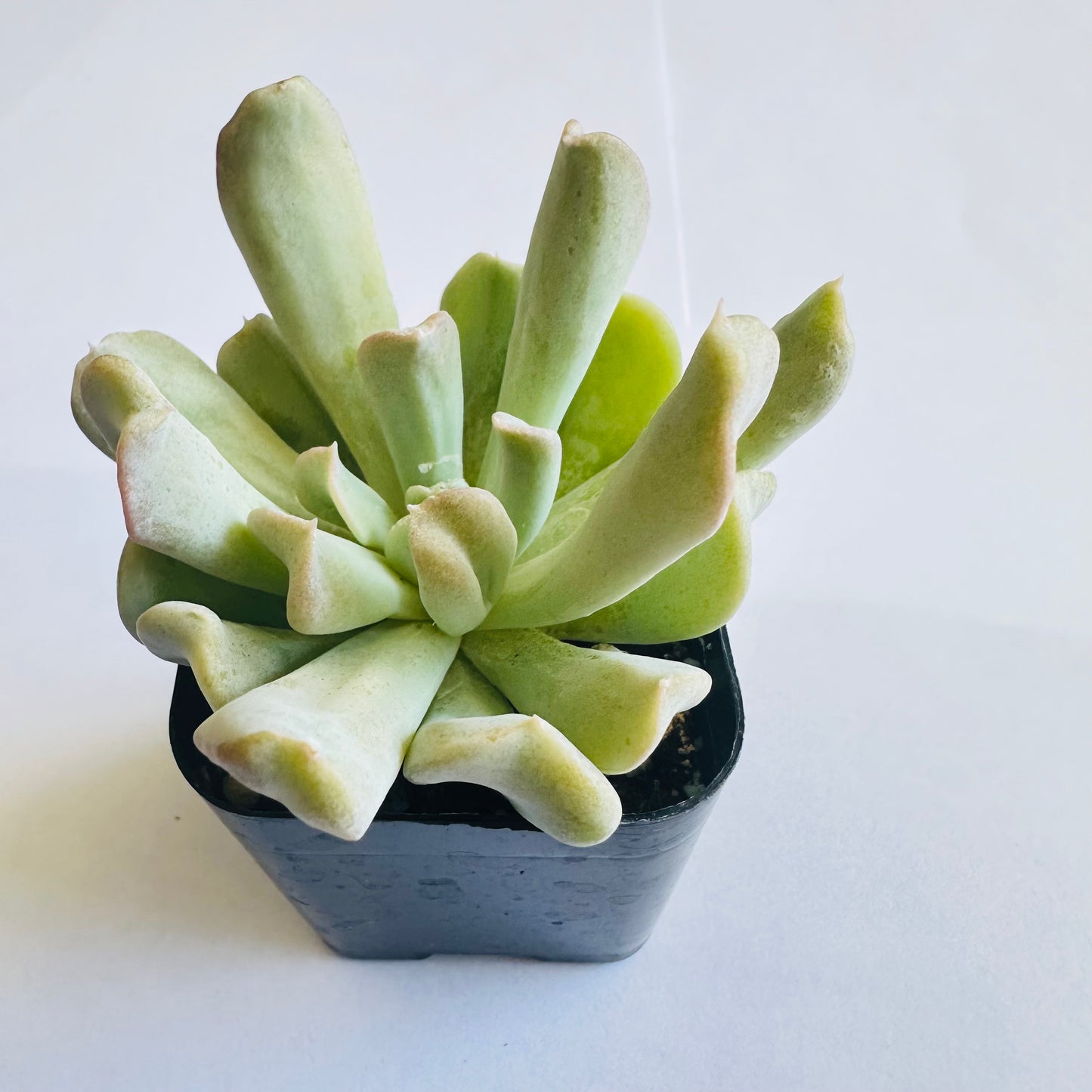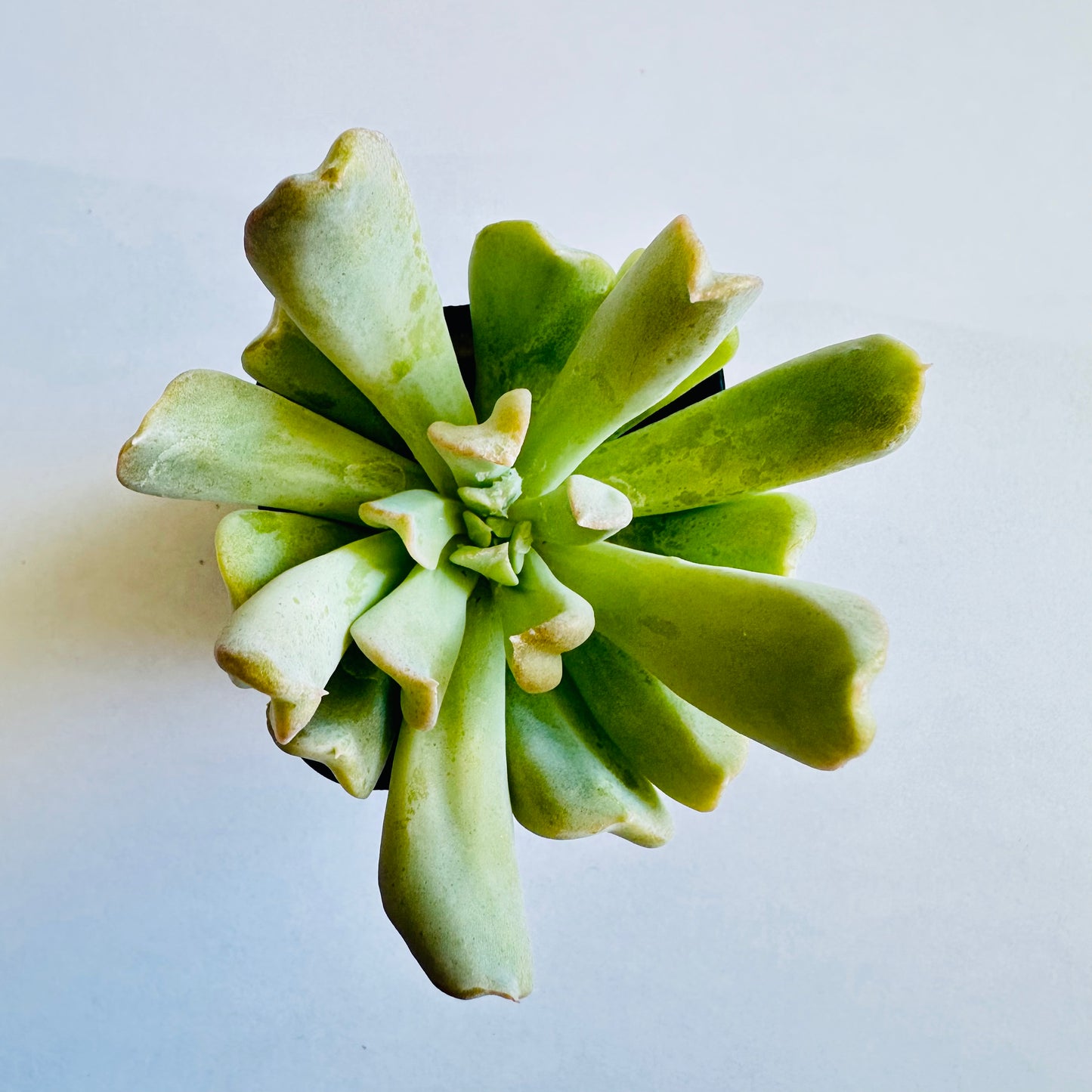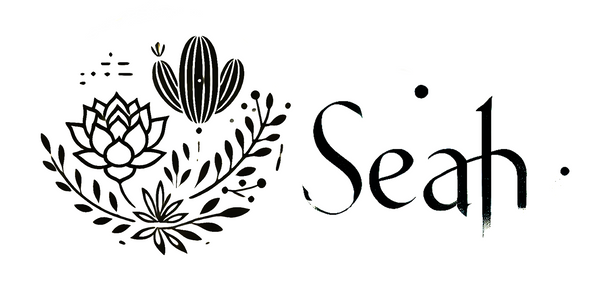Echeveria runyonii - Topsy Turvy
Echeveria runyonii - Topsy Turvy
In stock
Couldn't load pickup availability
📝 Description
Morphological Characteristics
Echeveria runyonii ‘Topsy Turvy’ is a distinctive succulent from the Crassulaceae family, known for its unique, architectural form. This plant features spoon-shaped leaves that curl dramatically downwards, with the tips pointing upwards, creating an intriguing “topsy-turvy” appearance. The leaves are a pale blue-green color with a powdery coating of natural wax that helps to reduce evaporation. This Echeveria forms a rosette that can grow up to 10 inches (25 cm) in diameter. In the fall, ‘Topsy Turvy’ produces orange-pink bell-shaped flowers on long, arching inflorescences, adding an extra layer of visual interest.
Growth Habits
Echeveria runyonii ‘Topsy Turvy’ is a fast grower compared to some other Echeverias and is known for its tendency to produce pups or offsets around the base of the mother plant. This succulent is perfect for container gardens or as a ground cover in dry, rocky areas. It prefers a warm, dry climate and thrives in conditions where it can receive plenty of sunlight. However, it can also adapt to indoor environments if provided with enough light.
Maintenance Points
• Lighting: Requires bright, indirect sunlight or partial shade. Too much direct sun can cause sunburn, while insufficient light can lead to etiolation (stretching).
• Watering: Water thoroughly when the soil is dry to the touch, then allow it to dry out completely before watering again. Overwatering can cause root rot, especially during the winter months.
• Soil: A well-draining succulent mix is ideal. You can enhance drainage by adding coarse sand or perlite.
• Temperature: Prefers average summer temperatures from 65-70°F (18-21°C). During the winter, keep it cool and dry—ideally between 50-55°F (10-13°C).
• Fertilization: Feed with a diluted low-nitrogen succulent fertilizer during the growing season (spring and summer), not more than once per month.
Reproduction Method
Propagation of Echeveria runyonii ‘Topsy Turvy’ is most effectively accomplished through offsets and leaf cuttings.
• Offsets: This plant frequently produces pups which can be gently removed once they have developed their own root systems. Separate them from the mother plant with a clean, sharp knife and allow the cuts to callous over for a few days before replanting in well-draining soil.
• Leaf Cuttings: Carefully twist a leaf from the rosette, making sure the base is intact. Let the leaf dry for a few days until the cut end callouses over, then lay it on top of soil. Mist the soil lightly until roots and a new rosette begin to develop.
Echeveria runyonii ‘Topsy Turvy’ is admired for its whimsical form and minimal care requirements, making it a popular choice for succulent collectors and as a striking addition to drought-resistant landscapes.
🌿 Care Tips
Plant Care
Light
Water
Soil
Temperature
Hardiness
Fertilizer
Propagation: Leaf/offset cuttings
Common issues: Etiolation, mealybugs, rot
🌟 Note: It’s normal for succulents to appear slightly shriveled after shipping. They usually recover within a few days in a suitable environment.
📦 Shipping Info
Seah Shipping Policy
Effective Date: November 2025
This Shipping Policy applies to orders delivered within the continental United States (the lower 48 states). By purchasing from Seah, you agree to the terms below.
1) Shipping Cost & Free Shipping
- Automatic rate calculation: Shipping is calculated at checkout based on weight, destination ZIP and carrier rates.
- Free Standard Shipping: Orders $59+ (pre-tax, after discounts) ship free to the lower 48 states.
- Alaska, Hawaii, Puerto Rico & other territories: Not eligible for free shipping or standard flat offers at this time.
- Taxes/Duties: Applicable sales tax and any fees are shown at checkout.
2) Processing Schedule
- Business days only: We process and ship Monday–Friday. No shipping on weekends or U.S. federal holidays.
- Handling time: 1–3 business days after payment confirmation.
- Cut-off time: Orders placed before 3:00 PM (PST) are prioritized for same-day processing; others roll to the next business day.
- Changes/Cancellations: Email support@seah.co within 12 hours of purchase; after that, the order may already be in processing.
3) Transit Times
| Method | Estimated Transit | Total ETA (Handling + Transit) |
|---|---|---|
| Standard | 5–8 business days | 6–11 business days |
| Express | 3–4 business days | 4–7 business days |
ETAs are estimates. Weather, holidays, carrier delays or high-volume periods may extend delivery times.
4) Seasonal Temperature & Plant Safety
- Winter (Nov–Mar): We strongly recommend adding a heat pack at checkout to protect plants from freezing. Orders shipped without a heat pack during cold conditions are not covered for cold damage.
- Summer heat: During extreme heat waves, we may hold shipments until temperatures normalize. We’ll notify you if there’s a hold.
- Packaging: Plants are carefully packed (bare-root or potted by type/size) to minimize transit stress.
5) Carriers & Tracking
- We ship via USPS / UPS / FedEx, selected automatically for best service to your address.
- When your order ships, you’ll receive a tracking email. Tracking typically activates within 24 hours.
- If you haven’t received tracking within 3 business days, contact us at support@seah.co or +1 (626)-999-1314.
6) Address Changes & Delivery Issues
- Before shipment: Request address changes within 12 hours of ordering.
- After shipment: We can’t modify the address once dispatched. Please contact the carrier for redirection options.
- PO Boxes: Supported for USPS only; UPS/FedEx require a street address.
- Seah isn’t responsible for delays or loss due to incorrect addresses provided at checkout.
7) Service Area
We currently ship to the continental U.S. (lower 48 states). Orders to AK/HI/PR and other territories are not eligible for free shipping and may be restricted.
8) Support
- Hours: Mon–Fri, 9:00 AM – 5:00 PM (PST)
- Phone: +1 (626)-999-1314
- Email: support@seah.co
- Address: 7870 Margaux Pl, Rancho Cucamonga, CA 91739, United States
Thank you for supporting our California nursery—each plant is hand-selected and packed with care. 🌱




